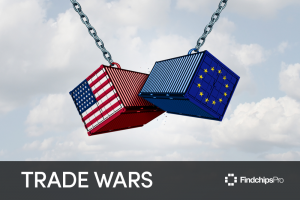A Zero-Sum Game: How Increased Tariffs Will Affect Nearly Everyone in The Electronics Industry

By Mike Muson, Senior Director, Supplyframe
The concept of tariffs makes sense, on paper. Taxing goods or services as they enter or leave a country is an effective means of balancing trade and encouraging domestic employment. When put into practice, however, many forget to consider the all-important balance these taxes represent.
The effects of these tariffs are also felt by every level of the supply chain. From sourcing and procurement to sales and even consumers. Enter the latest tariff increases from the Trump administration. While these tariffs have only recently gone into effect, global trade, supply chain professionals, and business owners are already feeling the sting.
What Tariffs are Increasing and Why?
It all began in January of 2018 when President Trump implemented tariffs on washing machines and solar panels. This was followed shortly after with tariffs on steel and aluminum. The administration has also seen fit to impose steep tariffs on a massive list of Chinese products.
The core motivation behind these decisions is economic in nature, but in the case of the Chinese tariffs, the motivation is a little different. An ongoing debate over the handling of U.S. intellectual properties in China sparked the decision to penalize the country via heavy tariffs.
To further enhance this argument, an investigation was launched by the United States Trade Representative (USTR). Seven months later, a report was released that offered a list of Chinese exports that could be subjected to a 25 percent tariff increase.
“We are concerned with a number of the items on the list and the impact that a 25 percent tariff will have on the global supply chain. The administration has been very clear that the goal is to reduce the trade deficit with China.”
– Jamie Girard, senior director of public policy for the SEMI trade group
Girard also pointed out that the U.S. has a trade surplus with China in semiconductor equipment, which further begs the question of why tariffs were imposed on these goods.
China is poised to match the value of tariffs by imposing a higher tax rate than the current 10 percent. Other world powers like Mexico, Canada, and even the European Union have also retaliated with their own tariffs.
How The New Tariffs Affect Electronics Manufacturing Supply Chains
 Chipmakers in the United States stand to be hit with pricing increases as a result of these tariffs, according to the Semiconductor Industry Association (SIA). While the SIA does share concerns over the intellectual property issues in China, they condemn the tariffs as a viable means of solving the issue, going so far as to call them “counterproductive.”
Chipmakers in the United States stand to be hit with pricing increases as a result of these tariffs, according to the Semiconductor Industry Association (SIA). While the SIA does share concerns over the intellectual property issues in China, they condemn the tariffs as a viable means of solving the issue, going so far as to call them “counterproductive.”
“We don’t think tariffs on our industry makes sense. It’s puzzling to see how we’re putting this tax on ourselves. We need to look to a different toolkit: the protection of IP.”
– Jimmy Goodrich, head of global policy at the SIA trade group
Most chipmakers research, design, and manufacturer chips in the United States before exporting them to China for testing, assembly, and packaging. These makers will be paying an additional tax on the re-importation of their finished products.
Major companies like Intel, Micron, and Texas Instruments, who manufacture in China despite being headquartered in the United States, will feel the effects as well. This all points to a negative impact on consumer electronics as a whole.
“As we’ve said all along, tariffs are taxes on consumers and a drag on the nation’s economy, this entire process creates uncertainty and makes it difficult for retail companies that must rely on complicated global supply chains”
– Matthew Shay, President and CEO of the National Retail Foundation
So, is there a silver lining in all of this? Gavin Weiner, the owner of Matronixs Limited, an LED manufacturer in Guangzhou, China, offers a different perspective:
“The cell phone makers are mostly automated, but passive components are the lifeblood of the industry. So if you hurt the bottom [companies that sell passives] companies, they will have to either drop their prices to get business or go out of business, which leaves a shortage of parts for the high-end finished products.
People talk about the USA companies that are losing sales in China, etc. No one is looking at the USA companies that will now be able to sell at a competitive price in the USA and will come in to fill the gap.
If the west is not manufacturing product, it would always be at a disadvantage and weak negotiating point of view. So it needs to find a way to make it cost-effective to produce in the USA again.”
– Gavin Weiner, LED manufacturer owner, Matronixs Limited, Guangzhou, China
Other components like capacitors, resistors, displays, and raw metals are all being hit my tariffs as well. In situations where the components must be sourced from China, smaller businesses will be forced to pass those costs on to the consumer.
A Supply Chain Professional’s Guide to Trade Wars
 With the tariffs in place on both sides of the conflict, the United States and China have found themselves locked in a trade war.
With the tariffs in place on both sides of the conflict, the United States and China have found themselves locked in a trade war.
With the level of globalization in current trade and supply chains, the damage from this trade war could be far more catastrophic. Savvy supply chain professionals will begin their preparations now, by seeking out the best possible pricing and procurement options. As the trade war wages on, sourcing and procurement teams will need up-to-date data and information in order to make profitable decisions.
Empowering your organization with accurate data, market trends, and alternative component options all contribute towards an agile and flexible supply chain strategy.











